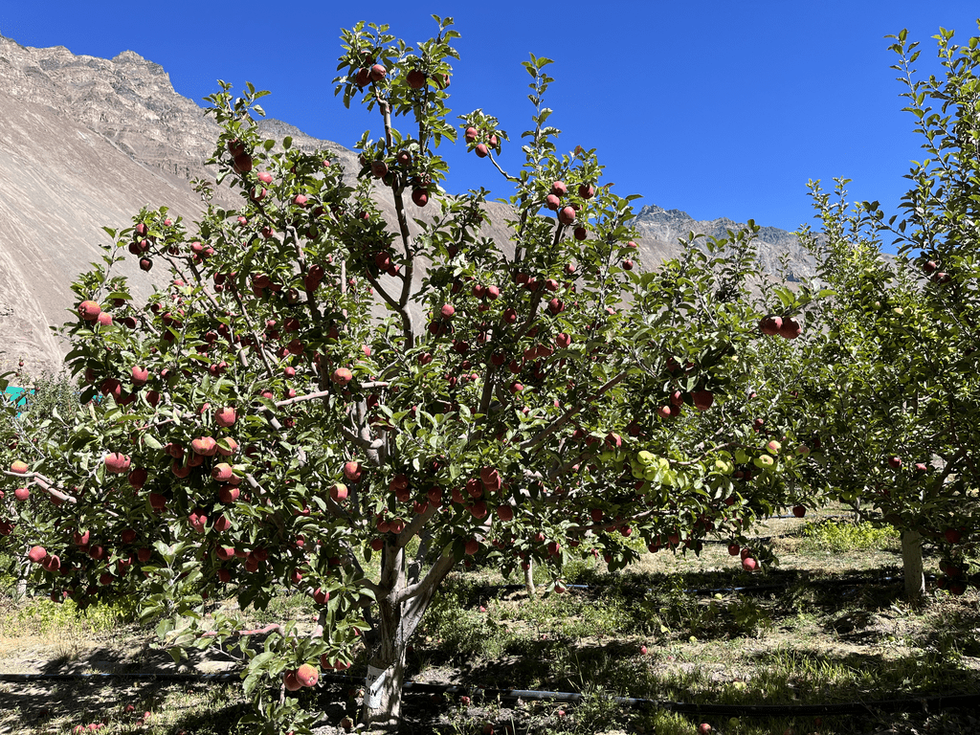The transformation of agriculture in Spiti Valley, Himachal Pradesh, exemplifies how venturing into the unknown can yield hidden treasures. Initially deemed unsuitable for apple cultivation due to its harsh climate, Spiti has seen a remarkable shift over the past three decades.
Initial Challenges
- Climate and Geography: Spiti’s climate, characterized by freezing temperatures, made apple cultivation initially unviable.
- Early Efforts: A few residents experimented with apple trees in their kitchen gardens, but with minimal success due to the harsh environment and lack of knowledge.
Gradual Warming and Agricultural Shift
- Temperature Changes: Gradual warming over the past few decades has made apple cultivation possible up to 3,400 meters above sea level.
- Transition from Traditional Crops: Farmers shifted from traditional crops like barley and potatoes to apples, recognizing the economic benefits.
Economic Impact
- Increased Income: Farmers’ incomes have significantly increased. For example, KT Bodh from Hurling village highlighted how apple cultivation revitalized household economies.
- Historic Perspective: Two decades ago, a farmer with 3-4 bighas earned Rs 4,000-5,000 annually from potatoes and barley. Today, similar landholdings yield much higher returns from apple cultivation.
Pioneers and Early Success
- Key Pioneers: Chhimet Dorje, Phunchok Rai, and Lobzang Dorje are celebrated as pioneers, starting with 30-35 Royal Delicious apple plants.
- Overcoming Irrigation Challenges: Despite the arid terrain, early farmers managed irrigation by transporting water from streams on mules.
Development and Modernization
- Impact of Natural Disasters: A 1975 earthquake led to the resettlement of Kaurik villagers in Hurling, where they began small-scale apple cultivation.
- Economic Growth: Farmers like Bodh now earn up to Rs 12 lakh from 10 bighas of apple orchards.
- Educational Opportunities: Increased income allows families to send children to pursue higher education in cities like Shimla and Delhi.
Scientific and Institutional Support
- Research and Extension: The establishment of the Regional Horticultural Research Sub-Station in 1981-82 provided scientific guidance, promoting apple cultivation.
- Krishi Vigyan Kendra (KVK): KVK, Lahaul & Spiti-II, established under ICAR-ATARI Zone-1, further disseminated scientific knowledge and techniques.
Agricultural Expansion and Market Reach
- Cultivation Spread: Apple cultivation has expanded to over 660 hectares in Spiti Valley.
- Production and Value: In the 2023-24 season, Spiti produced approximately 196,000 boxes of apples, valued at Rs 34 crore, reaching markets across India and for export.
Challenges and Future Prospects
- Climatic Limitations: Apple cultivation has not extended beyond 3,400 meters, causing envy among farmers at higher altitudes.
- Quality and Shelf Life: Spiti’s apples are renowned for their quality and shelf life, with future success depending on cultivation choices and scientific support.
Key Figures and Contributors
- Notable Scientists and Officials: Contributions from RS Spehia, Inder Dev, Ankita Dhiman, Bandana Dhiman, and Rajeshwar Singh Chandel have been crucial in supporting and advancing apple cultivation in Spiti.
Multiple Choice Questions (MCQs):
- What initially made Spiti Valley unsuitable for apple cultivation?
- A. Lack of water
- B. Harsh climate
- C. Poor soil quality
- D. Lack of government support
- Answer: B. Harsh climate
- What is the maximum elevation up to which apple cultivation is now viable in Spiti Valley?
- A. 3,000 meters
- B. 3,200 meters
- C. 3,400 meters
- D. 3,600 meters
- Answer: C. 3,400 meters
- Who are considered the pioneers of apple cultivation in Spiti Valley?
- A. KT Bodh and Subodh Kumar
- B. Late Chhimet Dorje, Phunchok Rai, and Late Lobzang Dorje
- C. RS Spehia and Ankita Dhiman
- D. Inder Dev and Bandana Dhiman
- Answer: B. Late Chhimet Dorje, Phunchok Rai, and Late Lobzang Dorje
- What significant event in 1975 influenced agricultural practices in Spiti Valley?
- A. Establishment of KVK
- B. Devastating earthquake
- C. Government subsidy
- D. Introduction of new apple varieties
- Answer: B. Devastating earthquake
- How much income did Subodh Kumar’s family generate annually from 10 bighas of land after transitioning to apple cultivation?
- A. Rs 4,000-5,000
- B. Rs 20,000-30,000
- C. Rs 12 lakh
- D. Rs 15 lakh
- Answer: D. Rs 15 lakh
